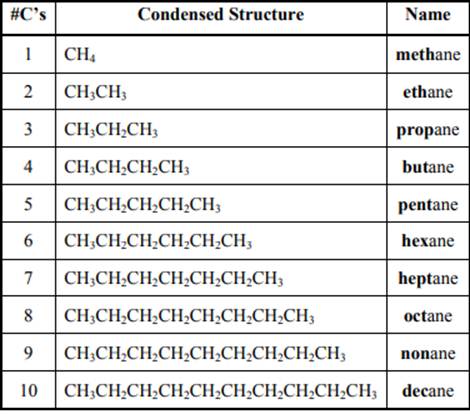
Custom eBook for Organic Chemistry
2nd Edition
ISBN: 9798214171104
Author: Straumanis
Publisher: Cengage Custom
expand_more
expand_more
format_list_bulleted
Concept explainers
Question
Chapter NW1, Problem 12CTQ
Interpretation Introduction
Interpretation: The information conveyed by “di” and “tri” in below figure should be given.

Concept introduction: The IUPAC name begins with prefix to designate the number of
The IUPAC system for nomenclature of straight hydrocarbon makes use of table given as follows:

As per IUPAC recommendations, longest chain found in a continuous manner in a branched molecule is chosen as parent chain. All the side chains are named in alphabetical order.
Expert Solution & Answer
Want to see the full answer?
Check out a sample textbook solution
Students have asked these similar questions
Heparin is used as an anti-coagulant. A risk of heparin use is thrombocytopenia, or low platelet
count. This risk is minimized with the use of low molecular weight heparins (LMWH), therefore it is
desirable to separate LMWH from higher molecular weight heparins. The method of choice to do
this is molecular exclusion chromatography. Below is a chromatogram from a molecular exclusion
chromatographic run. Peaks ranging from A to J are clearly distinguishable. The heparin mixture
that was analyzed had anywhere from 6 to 30 repeat units of monomer (where the heparin with 30
repeat units would be roughly five times the size of the heparin with six repeat units).
a. Which letter most likely represents the peak with 6 repeat units given these heparin polymers
were separated with molecular exclusion chromatography?
b. Explain your reasoning describing the mechanism of retention in molecular exclusion
chromatography.
100
80
60
60
Relative Abundance
40
40
E
GH
20
20
B
A
36 38 40 42 44 46 48 50
50…
HELP NOW PLEASE ! URGENT!
HELP NOW PLEASE ! URGENT!
Chapter NW1 Solutions
Custom eBook for Organic Chemistry
Ch. NW1 - Prob. 1CTQCh. NW1 - (E) Write a correct name below each of the...Ch. NW1 - (E) What suffix do all the names in Model 1 have...Ch. NW1 - (E) What prefix stands for eight carbons?Ch. NW1 - Prob. 5CTQCh. NW1 - Prob. 6CTQCh. NW1 - Prob. 7CTQCh. NW1 - Prob. 8CTQCh. NW1 - Prob. 9CTQCh. NW1 - Use Model 1 to propose names for three-, four-,...
Ch. NW1 - Prob. 11CTQCh. NW1 - Prob. 12CTQCh. NW1 - Prob. 13CTQCh. NW1 - Name the following alkanes.Ch. NW1 - (Check your work.) Explain what is wrong with each...Ch. NW1 - Prob. 16CTQCh. NW1 - Draw the following alkanes a....Ch. NW1 - Prob. 18CTQCh. NW1 - Draw structures that correspond to the following...Ch. NW1 - For mono-substituted cycloalkanes the “1” is not...Ch. NW1 - Prob. 21CTQCh. NW1 - Prob. 22CTQCh. NW1 - Prob. 23CTQCh. NW1 - Prob. 24CTQCh. NW1 - Prob. 25CTQCh. NW1 - Write the name of the molecule on the left using...Ch. NW1 - Prob. 1ECh. NW1 - Prob. 2ECh. NW1 - Name each of the following structures.
Knowledge Booster
Learn more about
Need a deep-dive on the concept behind this application? Look no further. Learn more about this topic, chemistry and related others by exploring similar questions and additional content below.Similar questions
- Draw a Newman projection for the molecule below from the perspective indicated. Which of the groups (letters A-H) are methyl groups? CH3 H H H A H B ☑ >> H. ABCDEFG I H -H CH3 G D CH F E Numeric 4 points How many gauche interactions exist in the conformation shown in the previous problem? 1arrow_forwardHELP NOW PLEASE ! ASAP! URGENT!arrow_forwardHELP NOW PLEASE ! ASAP! URGENT!arrow_forward
- Would the following organic synthesis occur in one step? Add any missing products, required catalysts, inorganic reagents, and other important conditions. Please include a detailed explanation and drawings showing how the reaction may occur in one step.arrow_forwardPls help.arrow_forward13) When solid barium phosphate is in equilibrium with its ions, the ratio of barium ions to phosphate ions would be: a. 1:1 b. 2:3 c. 3:2 d. 2:1 14) The pH of a 0.05 M solution of HCl(aq) at 25°C is 15) The pH of a 0.20 M solution of KOH at 25°C isarrow_forward
- Pls help.arrow_forwardPls help.arrow_forward16) A 2.0 L flask containing 2.0 x 10-3 mol H2(g), 3.0 x 10-3 mol Cl2(g), and 4.0 x 10-3 mol HCl(g) at equilibrium. This system is represented by the following chemical equation: H2 (g) + Cl2 (g) → 2HCl(g) Calculate the equilibrium constant for this reaction.arrow_forward
arrow_back_ios
SEE MORE QUESTIONS
arrow_forward_ios
Recommended textbooks for you
 Organic Chemistry: A Guided InquiryChemistryISBN:9780618974122Author:Andrei StraumanisPublisher:Cengage Learning
Organic Chemistry: A Guided InquiryChemistryISBN:9780618974122Author:Andrei StraumanisPublisher:Cengage Learning

Organic Chemistry: A Guided Inquiry
Chemistry
ISBN:9780618974122
Author:Andrei Straumanis
Publisher:Cengage Learning